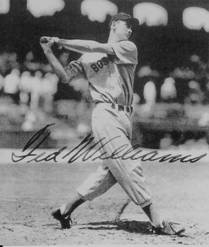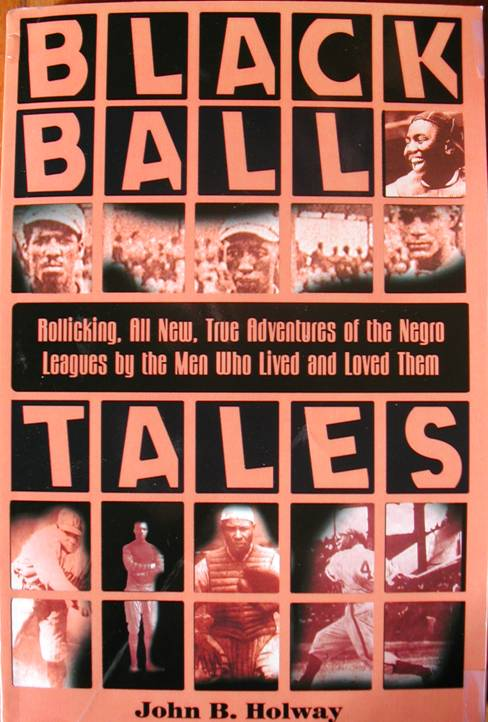
A-ROD AND MANNY AND TED
By John
B Holway
Alex Rodriquez has passed Ted Williams on
the exalted list of all-time home run hitters, and Manny Ramirez is waiting
to be next in line. A-Rod
slugged #522 in April. But it
took two wars to do it. I don't
mean
The Big War should have been the best years of Ted’s
life. He had just turned 24
when he left for Navy flight training at the end of the ’42
season. He was already the second
youngest. 400 hitter ever. He
had just won his first triple crown.
He had slugged more homers than anyone his age, ever. He was ready
for his greatest seasons.
Babe Ruth set records in each of the ages
Ted would miss – hitting 29, 54, and
59. Jimmie Foxx hit 58, Roger
Maris 60.
At those ages, Ted was also breaking new records – on the aerial
gunnery range at the Pensacola Naval Station.
When we compare Ted to all the other great
hitters, we are comparing them at their peaks to Williams before and after
his.
How many homers did Ted
lose?
Babe Ruth hit no less than 237 home runs in
Ted’s missing ages. In
the first three years, comparable to wm’ first stint in the Navy, Babe
set new records each year with 29, 54, and
59. In all five seasons he hit
no less than 237.
A-Rod used the first three years to pop 41,
52, and 57 homers – 150 in all.
Without them, he would now be sitting on 377, or 144 behind, and still
running to catch up. And he
wouldn't be able to count any in 2010 and 2011, Ted’s Korean
war ages. He'll probably pass
Ted sooner or later; it will just take him four or five years
longer.
If every batter in history had missed the
same five ages that Williams lost, he and Hank Aaron would be the only two
over 500. The leading home run
hitters would be:
Aaron
578
Williams
507*
Ruth
477
Griffey,
Jr. 441
Mays
439
Robinson
419
Mathews
414
McCovey
407
Thomas
381
Rodriquez
377
Ott
374
Foxx
360
Killebrew
358
Mantle
352
Banks
342
Schmidt
340
Ramirez
312
Gehrig
298
* I have deducted 14 that Williams hit in
two partial seasons during the Korean war years.
I don't include Bonds, McGwire, and Sosa, because their careers were
not typical. They had their
best seasons in their mid-to-late 30s.
Most other hitters hit their peaks at about the same ages Williams
lost.
I agree that Ruth lost many potential home
runs when he was pitching in the Dead Ball era; otherwise he would be higher
on the list. Hank Greenberg
and Johnny Mize missed four years in Service, Joe DiMaggio three, and Mays
one etc. But none of them lost
the same three big ages – 24 through 26 – that Ted
missed.
The list is intended only to suggest what a huge hole those five ages
would have left in the careers of everyone else.
Aaron’s impressive
total is based on longevity.
On a home run per at bat basis, he is far behind
Ted. And of course nobody on
the list batted 406.
I asked Williams about it in 1957 – believe
it or not, no one else had asked him
yet. His answer surprised
me. “Just take my lifetime
average and give me that.”
I
protested. Those weren't average
years he lost. Those were
mountain-top years in almost every other sluggers’ lives.
For example, Roger Maris,
a man with almost no previous home run credentials, suddenly shot up to 61
at the age of 26, the last year Ted spent in World War
II.
Could Ted have done it?
He shook his head
firmly: “I had that park against
me.”
I also believe Williams could have hit .400
at least once in the missing five seasons, maybe
more. He was the second youngest
400-hitter when he entered the Navy (Joe Jackson was a few months
younger). In Williams’
first three missing years, Ty Cobb, who had never batted.400 before in his
life, hit .420, .410, and .390.
Rogers Hornsby also reached .400 and
averaged
.385. Why couldn't Ted have
done it?
Furthermore, the Red Sox might have won two
pennants in those years. The
Sox players were about three years younger than the Yankees, man for man,
and they were just coming into their peak seasons, as the Yanks were just
passing their peaks. The Cardinals
proved that by beating
The Curse of the Bambino should really be
called “The Curse of World War II.”
Imagine Williams in two, maybe even three,
World Series in the little bandboxes of Brooklyn or
After listening to me, Ted
interrupted. “I don't want
to take anything away from what other guys did,” Ted
said.
But, he admitted, “some day I'd like
to put up a plaque on a rec room wall of all the home run hitters in history,
and put me down where I'd be if there hadn't been any
wars.”
Where do you
you think he would
rank?

 “If you think
you've read everything about Ted Williams, think
again. I knew him for
65 years since we were friends in high school, and I've never
read any book like this one.
Holway has new facts and statistics and pictures on almost every
page. He spent hours talking
to Ted and found out things Ted never told anyone
else. Most people don’t
know that he was half-Mexican or how his uncles taught him to play, and even
I didn't know that he called his shots on at least 17 home
runs. There’s a lot of
new stuff on his battles with the writers, his famous All Star Game home
run, Joe DiMaggio’s streak, and about Cobb, Sisler, Hornsby, and other
.400 hitters. This book really
brings the man and that era to life.
It’s a box seat ticket to
history.”
Bob Breitbart, director, San Diego Hall of
Champions.
“If you think
you've read everything about Ted Williams, think
again. I knew him for
65 years since we were friends in high school, and I've never
read any book like this one.
Holway has new facts and statistics and pictures on almost every
page. He spent hours talking
to Ted and found out things Ted never told anyone
else. Most people don’t
know that he was half-Mexican or how his uncles taught him to play, and even
I didn't know that he called his shots on at least 17 home
runs. There’s a lot of
new stuff on his battles with the writers, his famous All Star Game home
run, Joe DiMaggio’s streak, and about Cobb, Sisler, Hornsby, and other
.400 hitters. This book really
brings the man and that era to life.
It’s a box seat ticket to
history.”
Bob Breitbart, director, San Diego Hall of
Champions.
“Well done. There
were plenty of people who racked Ted up and wanted to bring out the bad in
the guy. He had a lot of pressure
on him, but he was a really compassionate
guy. Holway has told it like
it is.”
Bobby Doerr,
Hall of Fame, Red Sox 1938-50.
“The ballplayers all loved
Ted. He was a great hitter,
a great human being, and a great friend.
Holway’s book captures the spirit of those years –
absolutely. Reading it is like
being there in person. Every
serious baseball fan should have it in his library or on his coffee
table.”
Bob Feller, Hall of Fame, Indians,
1936-56.
“Holway is the John Wayne
of the keyboards.”
John Thorn,
editor, “Total Baseball.”
About The
Last 400 Hitter
 “Holway’s
accounting of the miraculous 1941 season is a joy to
read. Thoroughly researched
and carefully detailed, it is an affectionate tribute to a ballplayer, a
season, and an era.”
“Holway’s
accounting of the miraculous 1941 season is a joy to
read. Thoroughly researched
and carefully detailed, it is an affectionate tribute to a ballplayer, a
season, and an era.”
$35 + $4 s&h, soft
cover. Scorpio Books,

Ted Williams recalled that in his rookie year of 1939, at each city
the veterans pointed out, “Josh Gibson hit one there…. That's where
Josh Gibson hit one.”
“Well,” said Ted, “nobody in
our league hit ‘em any
farther than
that.”
Read about:
Doc Sykes, who hurled a
no-hitter, out-raced KKK night-riders, and watched a cross being burned on
his lawn.
Laymon Yokely, who whiffed
Jimmie Foxx and Hack Wilson; Hack handed him his bat, saying, “Here,
you take it, it’s no use to me.”
Frank Duncan, who started
a riot and later sent Jackie Robinson to the Dodgers..
Connie Johnson, who reached
the majors and tells of dueling Williams at the plate.
Piper Davis, who dazzled
Globe Trotter fans and taught a teen-age rookie to get back up after
a beaning.
“You taught me to survive,”
Willie Mays told
him. “You were the pioneers,
you made it possible for us.”
“Blackball Tales,
Holway’s third series of oral compilations relates the joys, travails,
and aspirations of members of the Negro
Leagues. Holway has done as
much as anyone to chronicle the story of segregated
baseball. Highly recommended
for general libraries.”
Library Journal.
$30 + $4 s&h softcover